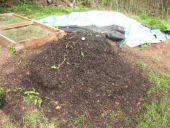posted 9 years ago
I agree with Keith Odell. Worms don't always do what we tell them to. Mostly, they go up, not down, but they prefer to do what they jolly well want. If they think there's enough food and moisture where they are, they won't go anywhere. Younger worms are more likely to move to the newest, groovin'est place. Older worms are more likely to kick back for a while longer before they feel obligated to pack up and move on. I've found many a fat, lonely worm lounging around on a bin bottom or in a corner, not realizing that it wasn't keeping up with the program, and not caring.
I mostly work my bins side to side, and I don't be in a hurry while I'm at it, because they sure won't be. If my bins start getting really full, I'll start feeding more on one side than another, and eventually only on the one side. The worms will eventually get the idea. Once they do, I'll harvest the compost on the side I haven't been feeding on, until I get to where the worms are. Then I fill that empty side and start over. When it's time to harvest compost again, I'll feed the other side, and harvest from the side I didn't the last time. But I let them set the pace.









